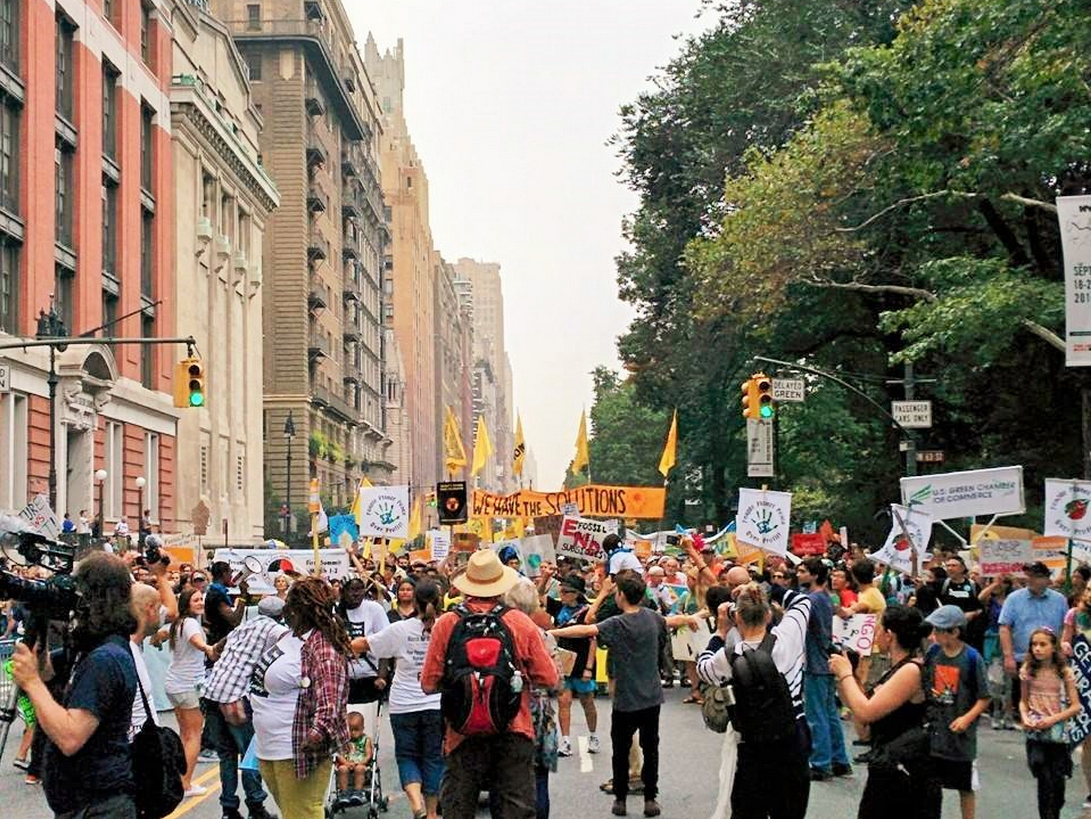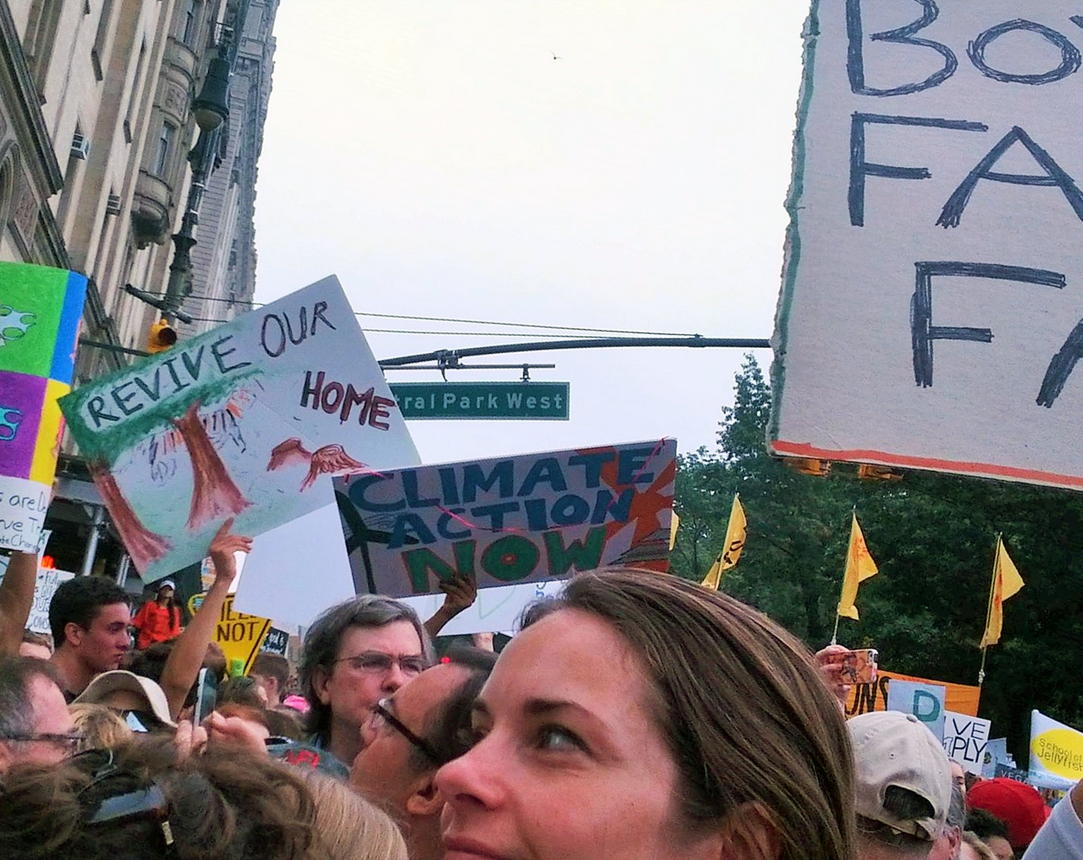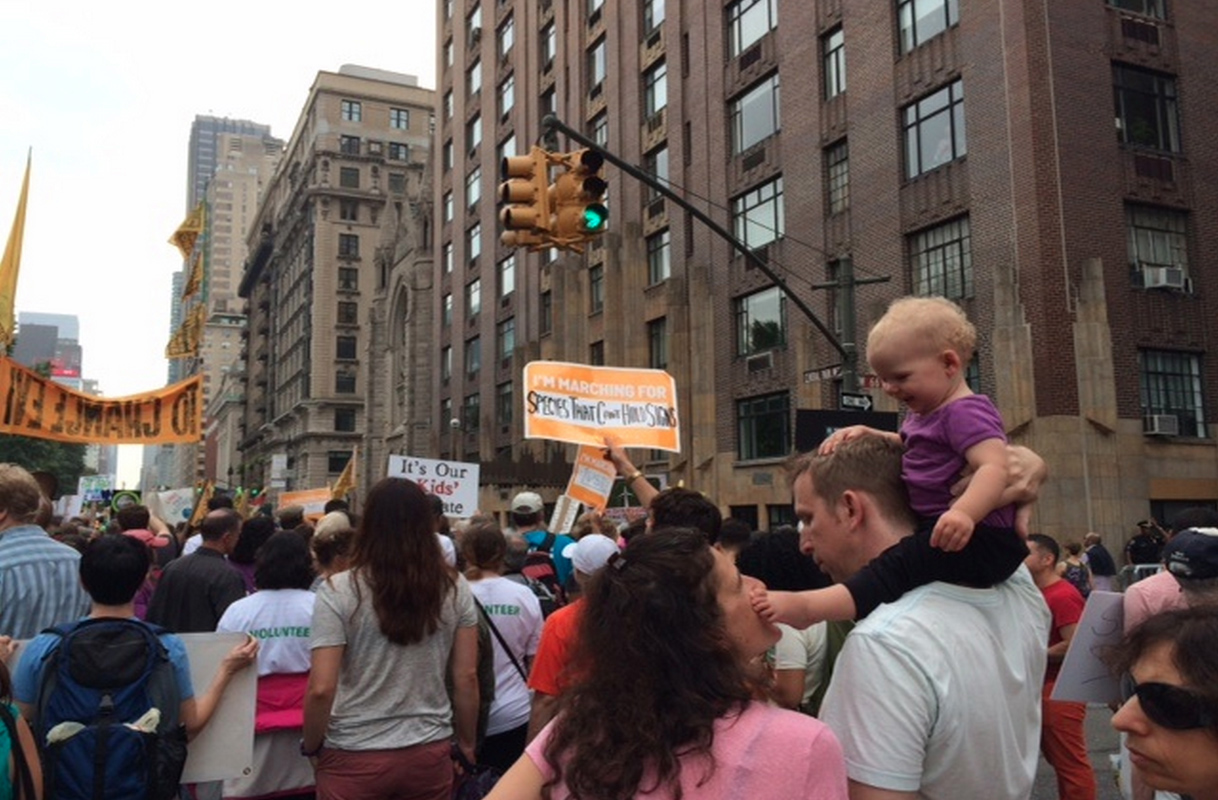
A week after the People’s Climate March took over midtown Manhattan, four of the City Atlas interns who were in attendance, along with the editor, shared thoughts. How did it go, and where do we go from here?
Chiara Zaccheo:
For me, the People’s Climate March started on the subway. I remember thinking to myself that this is definitely the most people I have seen out and about on Sunday morning! Each stop we passed, more and more people got on our train car. Soon I was standing next to a tree, a polar bear, two kids dressed as bumblebees, and an abundance of homemade signs. Outside of the subway I first spotted a giant melting world ice cream cone.
What struck me about the march was the diversity of people and climate change issues represented, and the level of commitment. I started at 86th Street with family and friends. It took us four hours to move four blocks, but we, as well as our fellow marchers, stayed. We weren’t going anywhere. I think that was the most inspiring and motivational part of the march – a crowd estimated at more than 300,000 people stayed, marched, engaged in moments of silence together, and chanted in solidarity. Climate change justice is truly a unifying issue because it affects all facets of life.
The enormous crowd held a moment of silence to honor those affected by climate change. (Video by Kevin Burget)
William Wepsala:
Marching with hundreds of thousands of people was invigorating and inspiring. I definitely think the organizers achieved their goals of visibility and putting the climate back on the agenda for some, and on the agenda for the first time for others.
In recent years, it seems that commitment to climate has receded from public discourse and been a talking point of the elite. Without a large issue like the Kyoto Protocol on people’s minds, it’s easy to forget. For some, the UN’s release of the most recent IPCC Report was a momentous occasion, but for many it was just another un-clicked headline.
I think the march was valuable by reminding people that we are in the fight for the long haul, and that we’re all in it together.

Joseph Lin:
The People’s Climate March truly felt like it was for the people. A broad coalition ranging from different environmental groups to LGBTQ activists and veterans were present to ensure that climate change was a priority that intersected with immigration reform, indigenous rights, and other issues. I appreciated the emphasis of communities of color at the frontlines of environmental burdens, as reflected in the march lineup featuring racial justice organizations in the lead. Moreover, despite the march’s estimated 300,000-plus attendees, the march led an effective moment of silence that commemorated disadvantaged demographics facing disproportionate environmental consequences. The publicity campaign for the march was well organized via the website graphics and short film, making for outreach to wide audiences. Even though the march addressed the sobering reality of the Earth’s climate, marchers attended the event in droves with their energy and spirit fit for a celebration.
However, during the march, the messaging may be muddled in the myriad of social justice agendas. There was an emphasis on the visibility of those concerned with climate change, but no list of demands. There wasn’t a rally with inspiring speeches.
After the march, the aftermath shows that those dedicated to climate change must also consider the sustainability of the movement’s activism in itself. Are the clever signs and informational flyers created with recycled paper? Where will marchers discard their garbage and will it be sorted appropriately?

Mallorie Thomas:
I joined the cohort along 86th Street, and was immediately taken aback by the sheer numbers, people who seemed to be from all parts of the country, all marching along this avenue that I regularly walk down. Inching forward along the sidewalk, I noticed a middle-aged woman emerge from her brownstone. Dressed casually and toting her miniature Maltese, she seemed astounded, whipping her head in both directions to fully take in the scene in front of her. She quickly realized that her morning walk to take her dog out would be way more difficult this particular day because she physically could not cross the street. Shades of annoyance and frustration flashed across her face as she turned to a young man to her right, “What is this?! Why are you even here?!” The young man began to laugh, and just continued walking.
Moments like this make me realize that the issue of climate change, and specifically the march (an event that was well advertised) may be visible only to people in a certain sphere. But while climate change can affect certain communities more than others (taking into consideration geography and vulnerability), it is an issue that will, and has, affected everyone. Moving forward, as the issue of climate change and policy continue to be discussed, I hope that all demographics of New York City are inspired and encouraged to get involved. It is now our challenge to find ways to make this topic, which for many can feel like an issue only scientists engage with, a social issue so current unengaged parties can realize its relevance and the opportunities for action.
Richard Reiss:
There was great diversity to the crowd, except for two groups that I wish were evident. The two groups I’m thinking of are crucial to the future of New York City, and in fact to the planet as a whole.
[pullquote align=”left”]Can we imagine the cultural conditions that might permit a dialogue between New York and Oklahoma?[/pullquote]For over 25 years the world has known exactly what the problem is, and most of the solutions, but until our divided politics in the US are resolved, there is little chance of moving forward. And I’m not even sure this makes everyone in the world unhappy, because as a result, we can all essentially hide behind the electorate of Oklahoma (and the other red states), and continue to run our lives and economies without any effort at checking emissions — which in the short term, is much, much easier. Since Oklahoma won’t let us govern ourselves, we don’t have to change. Because of Oklahoma, the New York Times doesn’t even have to change the ideas in its Travel Section, though the Science Section knows that flying damages the place you’re flying to.
How could a march in New York City change this dynamic? Can we imagine the cultural conditions that might permit a dialogue between New York and Oklahoma yielding a solution in the time we have left to hold to the 2°C target?
The march I saw showed a great expansion of involvement, particularly from groups not usually represented and directly at risk; indigenous people, workers, low income families near the shore. Leaders from the Pacific Island states, canaries in the coal mine for climate change, marched, and of course, Ban Ki-moon.
But to me, it looked like a high turnout from a small section of our society. I’d like to see marches in Oklahoma, Texas, Louisiana, and Florida — they all have reasons to be leading on this issue. And if we know those states might be able to solve the political problem, is it worth focusing on what forces, entreaties, opportunities might make that happen?
[pullquote align=”right”]The fact that Americans can’t talk to each other is at the top of the world’s problems.[/pullquote]Might figuring out how to reach across the political divide be the single most pressing issue in the history of New York City, with success being the greatest benefit to the world? Hypothetically, if New York City opened up a channel of communication by issuing bonds that built new models of nuclear power plants across the South, replacing coal, would that be an effective use of the city’s money? Would that be wiser than a new round of levees in thirty years? (And if you don’t think a new round of levees would be in the cards otherwise, you may not be paying close enough attention. To paraphrase climate scientist Kevin Anderson: we’re ‘adapting’ for only 2°C, but we’re cutting emissions for about a 4°C target. Or above. And to understand why we need the South to have vast amounts of cheap, clean power, it’s because we next need to talk them into driving electric pick-up trucks.)
The fact that Americans can’t talk to each other is near the top, if not at the top, of the world’s problems, whether we recognize it or not. New Yorkers David Koch (Park Avenue) and Rupert Murdoch (Flat Iron) are successful at influencing affairs in Oklahoma, and that should really be a spur for other motivated groups in New York to do a better job.
The second group I have in mind: if even 40% of our hyper-wealthy, some of whom who had the march on their doorstep, felt the same way as the marchers, perhaps almost the same impact could be achieved.
The wealthy have reasons to engage too. The vulnerability of the poor is known, but without rapid and profound emission cuts, the destructive effects of climate change will reach everyone, or their offspring. As the Smithsonian Institution puts it in their new statement on climate change, “The situation is becoming critical for wild species and for the preservation of human civilization.” Translation: without rapid intervention, at some point will be hard for anyone on Planet Earth to be rich. This last idea is beginning to register.
[pullquote align=”left”]For many recent arrivals, New York is a place you come to get rich, not to march.[/pullquote]Another way to look at the above questions, from the perspective of someone at the march: why exactly are we doing these absent groups work for them? This is not an issue that involves an isolated, vulnerable community, or a fragile species. This involves everyone, as though our entire human society is trapped together in a burning building. If there were a way to shift this problem away from the boundaries of identity politics, that would be a step forward.
Lastly, I’m not sure how many people in the march really understand the scope of change. Because we’ve left the energy transition so late, it won’t be smooth. To stay within the 2°C target, or even close to it, will be quite a bump. Here’s how Eduardo Porter, economic writer in the New York Times, opened a column in July:
Here’s what your future will look like if we are to have a shot at preventing devastating climate change.
Within about 15 years every new car sold in the United States will be electric. In fact, by midcentury more than half of the American economy will run on electricity. Up to 60 percent of power might come from nuclear sources. And coal’s footprint will shrink drastically, perhaps even disappear from the power supply.
350.org and Avaaz did a great job getting the march organized and into the record books, but they keep the message focused on external enemies (ie., the fossil fuel industry), and conspicuously avoided a clear description of what a “350” lifestyle might be like. More accurately, a “450” lifestyle —since we’re likely to cross that mark even if we have rapid engagement. Saul Griffith has sketched it out, as Erin Wong has noted in previous City Atlas posts.
And there’s the brunt of the challenge. For many college-educated New Yorkers — especially the ones not at the march — New York over the past couple of decades has been a place to come to get rich. The city is very much shaped for that purpose, as you can see from the price of real estate. Wall Street is the lopsided economic engine of the city, with only 5% of the jobs, but 22% of the payroll. The financial industry has boomed in proportion to the otherwise sluggish US economy: 2.5% of GDP in 1948, and triple that, 7.7%, now.
Naomi Klein is doing her best to talk us out of consumerism, but the New York that currently exists is virtually a religion of materialist ideals; New Yorkers are friendly to books, but beyond the precinct of the march, given the substance of her message about ‘changing everything,’ it’s as though she’s teleported to a Mayan temple in 800AD, telling the inhabitants they are doing it all wrong. I’d like to believe that she can get the elites and working classes of New York to adopt entirely new values, but materialism is the foundation of many smart, gifted people’s lives and identities. People work 80 – 100 hour weeks, relentlessly out-competing their peers for a slice of consumer glamour they can call their own.
I’m describing all of the above to put a climate march in New York City in perspective. I think the more limited aims of constructing dialogue with red states about energy, and better engaging the ultra wealthy, are more achievable than Klein’s idea of remaking society top-to-bottom. But what’s realistic? We’re outside the realm of realism in every direction. An “all of the above” strategy probably makes the most sense.
And, maybe there is a tremor in the system. Maybe people are re-thinking their plans, and Klein and her book are part of a larger picture. Messages will only get louder. One might think of Jerry Seinfeld as a kind of anti-Klein – he kept his show moral-free – and yet here he is, a week ago…after the march passed his old neighborhood…accepting an award for advertising with one of the most unusual acceptance speeches ever. Who can describe materialism better than a man who made a show about nothing?